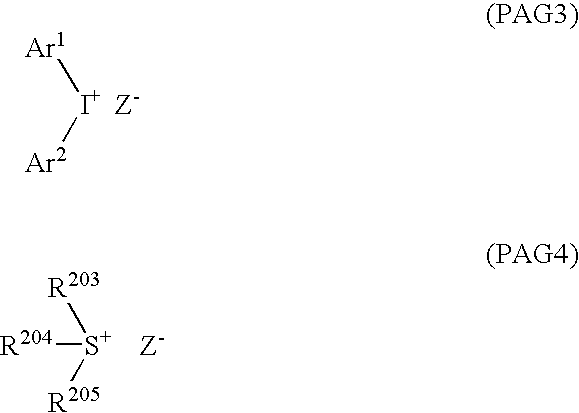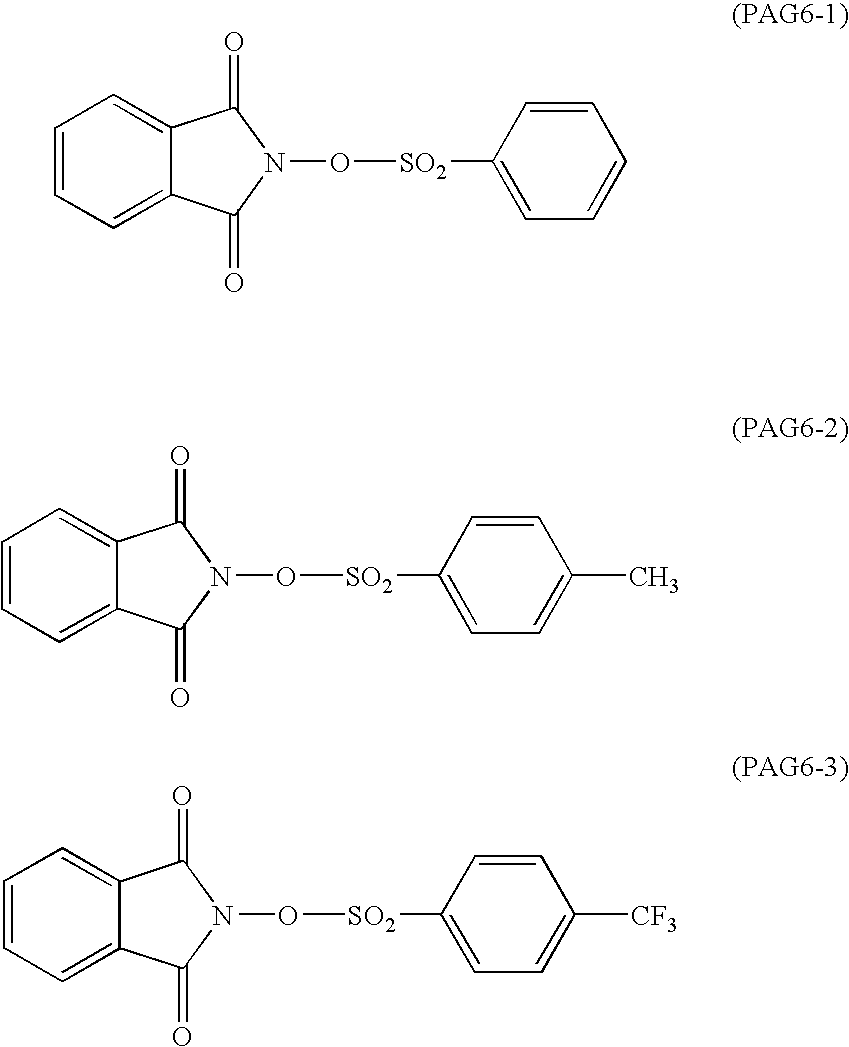Positive resist composition
a technology of composition and resist, applied in the direction of auxillary/base layers of photosensitive materials, instruments, photosensitive materials, etc., can solve the problems of yield reduction, rough line edge roughness, development residue, etc., and achieve the effect of positive resist composition, less formation of scum, and excellent line edge roughness
- Summary
- Abstract
- Description
- Claims
- Application Information
AI Technical Summary
Benefits of technology
Problems solved by technology
Method used
Image
Examples
synthesis example 1
Synthesis of Compound (S-16)
[0420]Into a three-necked flask was put 18 g of sodium hydroxide (60% assay), 200 ml of tetrahydrofuran (THF) was added thereto to dissolve (suspend) with stirring. Then, to the reaction solution was added dropwise a solution prepared by dissolving 78.1 g of commercially available diacetone-D-glucose in THF at room temperature. After stirring the mixture at room temperature for 30 minutes, 64.4 g of tert-butyl bromoacetate was added to the mixture, followed by stirring at room temperature for 2 hours.
[0421]The reaction mixture was poured into water, and after quenching the excess sodium hydroxide, it was extracted with ethyl acetate, and washed with water. The organic phase was concentrated to obtain a crude desired compound.
[0422]The crude desired compound was recrystallized from n-hexane including a small amount of ethyl acetate, thereby obtaining the desired compound as a white crystal.
[0423]A melting point of the compound obtained was 97.5 to 99.5° C....
synthesis example 2
Synthesis of Resin (6) (Main Chain Type)
[0434]Into a separable flask were put tert-butyl ester of norbornenecarboxylic acid, butyrolactone ester of norbornenecarboxylic acid and maleic anhydride in a molar ratio of 40 / 10 / 50 and tetrahydrofuran in an amount necessary for forming a solution having a solid content of 60% by weight, and the solution was heated at 60° C. under a nitrogen gas stream. After the reaction temperature was stabilized, 2% by mole of a radical initiator (V-601 manufactured by Wako Pure Chemical Industries, Ltd.) was added to initiate a reaction. After heating for 12 hours, the resulting reaction mixture was diluted twice with tetrahydrofuran and poured into a solvent mixture of hexane and isopropyl alcohol (1 / 1 by weight) to deposit white powder. The powder was collected by filtration and dried to obtain Resin (6).
[0435]Resin (6) was subjected to molecular weight analysis by a GPC method and it was found that a weight average molecular weight thereof calculated ...
synthesis example 3
Synthesis of Resin (8) (Hybrid Type)
[0440]Into a reaction vessel were put norbornene, maleic anhydride, tert-butyl acrylate and 2-methylcyclohexyl-2-propyl acrylate in a molar ratio of 35 / 35 / 20 / 10 and dissolved in tetrahydrofuran to form a solution having a solid content of 60% by weight, and the solution was heated at 65° C. under a nitrogen gas stream. After the reaction temperature was stabilized, 1% by mole of a radical initiator (V-601 manufactured by Wako Pure Chemical Industries, Ltd.) was added to initiate a reaction. After heating for 8 hours, the reaction mixture was diluted twice with tetrahydrofuran and poured into hexane of five times in volume to deposit white powder. The powder was collected by filtration and dissolved in methyl ethyl ketone and the solution was poured into a mixed solvent of hexane and tert-butyl methyl ether (1 / 1 by weight) of five times in volume to reprecipitate. The white powder deposited was collected by filtration and dried to obtain Resin (8)....
PUM
| Property | Measurement | Unit |
|---|---|---|
| temperature | aaaaa | aaaaa |
| temperature | aaaaa | aaaaa |
| temperature | aaaaa | aaaaa |
Abstract
Description
Claims
Application Information
 Login to View More
Login to View More - R&D
- Intellectual Property
- Life Sciences
- Materials
- Tech Scout
- Unparalleled Data Quality
- Higher Quality Content
- 60% Fewer Hallucinations
Browse by: Latest US Patents, China's latest patents, Technical Efficacy Thesaurus, Application Domain, Technology Topic, Popular Technical Reports.
© 2025 PatSnap. All rights reserved.Legal|Privacy policy|Modern Slavery Act Transparency Statement|Sitemap|About US| Contact US: help@patsnap.com



